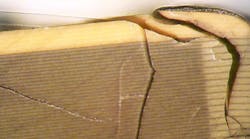As part of efforts that may lead to new types of armor, the U.S. Army Research Laboratory is working with researchers from the University of Florida on light-weight ceramic materials that resist fracture. By studying how materials fail through cracking, improvements in durability are being sought. The ceramic materials eventually break down into a granular-type state through a process called comminution.
“While various ceramic materials possess high hardness, they fail easily when pulled apart,” explains Dr. Sikhanda Satapathy of ARL’s Soldier Protection Sciences Branch. “That is, when subjected to tensile forces. The amount of tension that these materials can withstand before failure is a small fraction of the compression they can withstand.
“As a result,” Satapathy added “high-velocity impact of bullets and fragments causes extensive cracking and fragmentation of the material, reducing its ability to fully utilize its superior hardness to resist complex stress states generated by the impact event.”
Teamwork between the University of Florida and the U.S. Army Research Laboratory (ARL) has led to a new model for determining the shear strength of various ceramic materials to help in analyzing materials for use as armor. (Graphic courtesy of the U.S. ARL)
Traditionally, the relationship between the granular material’s ability to withstand compression and its ability to resist shearing deformation—which causes material to change shape—is described by the Mohr-Coulomb model. It approximates a material’s resistance to shearing deformation (its shear strength) as a linear function of applied pressure.
In reality, a material’s shear strength does not increase linearly with pressure and will saturate at high pressures. Researchers at the University of Florida have developed a new model for this material property, studying the stress states at which various ceramic materials have failed as reported by different researchers.
This teamwork between ARL and the university led to an improved granular response model, along with a dynamic cavity expansion modeling framework to capture the responses of different ceramic materials to impact-induced stress—including compression, tension, and shear. The modeling framework uses the pressure required to expand a cavity in an intact material to characterize the material’s capability to resist deep penetration. The pressure will be dependent upon how the material responds to compression, tension, and shear forces.
The new model is showing applicability to a broad class of ceramic materials, reducing requirements for expensive experiments to learn more about those materials and paving ways for their possible future uses in armor applications.


